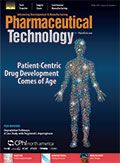Digitizing to Modernize Manufacturing
Moving from paper-based to digitalized processes is the first step to enabling quality management and manufacturing to work in sync.
seventyfour - stock.adobe.com

There is a significant opportunity for digital technology to improve quality and efficiency in pharmaceutical manufacturing. Life-science organizations that replace paper-based processes and siloed systems with modern digital applications are better positioned to meet current and future drug manufacturing demands, especially as the industry embraces precision medicine and treatments become more individualized.
The pharmaceutical manufacturing plant floor is ripe for digital transformation, where it can enable operators to quickly find current information and gather data in real time for smarter decision-making. Organizations are moving to modern cloud solutions to connect people, processes, and technology for greater agility and efficiencies. With a digitally connected facility, operators can use mobile devices to enter quality data or access the right information at the right manufacturing station at the point of need.
Precision medicine is transforming supply chains
In 2018, FDA approved 62 new therapeutic drugs, of which 25 were personalized medicines (1). This emerging approach to disease treatment targets a patient’s unique molecular and genetic profile and requires changes in the way that products are manufactured. Precision medicines are typically made for small groups of people with hard-to-treat illnesses and can be complicated to produce and difficult to scale.
Additionally, with many precision therapies, the patient becomes an integral part of a highly specific end-to-end manufacturing process. For example, with chimeric antigen receptor (CAR) T-cell therapy, approved for relapsed and refractory leukemia and lymphoma, the patient’s cells are collected at the hospital, shipped to a manufacturing center for engineering to target the person’s specific cancer, and then sent back to the hospital for infusion into that patient.
Traditional, large-scale drug manufacturing processes are not aligned with this highly individualized approach. The success and scalability of personalized medicine requires new strategies for automation and improved workflows to produce them reliably, safely, and economically.
Opportunity for change on the manufacturing plant floor
Today, much of the information on the pharmaceutical manufacturing floor is buried in paper binders or siloed applications. Without centralized systems for tracking and distributing content and intuitive applications that offer easy access, operators cannot quickly access the right information they need to perform their jobs and increases compliance and quality risks. Significant overhead is required to ensure that work instructions, standard operating procedures, and other information workers need to perform their jobs remain up-to-date and accurate.
If there are systems in place, they are disconnected. As a result, business process gaps between quality management systems (QMS) and content management applications develop, making it challenging to deliver quality products effectively.
Additionally, companies may try to get as much value as they can from their quality management and manufacturing systems by operating them way past their shelf life. This practice can actually increase costs because aging systems tend to be over-engineered and customized, and require frequent maintenance. Older systems are often too rigid to adapt to new processes, manufacturing or training methods, or production requirements, and they cannot efficiently scale down for small batch production.
The life-sciences industry has continued to lag other industries in adoption of new technologies. In a recent survey by Deloitte with MIT Sloan Management Review, only 20% of biopharma companies are maturing digitally (2). Leveraging modern solutions to enable timely delivery of information to the plant floor and tying real-time data with quality management systems can improve agility and help manufacturers meet requirements for innovative therapies such as personalized medicines.
Companies like Samsung BioLogics, a large contract development and manufacturing organization for biologics, are taking a fresh approach to ensure that they remain efficient and agile as they scale. Leveraging modern technology and its parent company’s manufacturing expertise and experience, Samsung BioLogics is progressively building larger and more advanced facilities that can run continuously 24 hours a day, seven days a week. “It’s challenging to manage and maintain information on the manufacturing floor and ensure operators are working from the latest procedures,” said James Choi, chief information officer at Samsung BioLogics. “Delivering content directly to manufacturing stations through a mobile application will make it faster for teams to stay up-to-date.”
Going mobile for greater plant agility
Mobile devices such as tablets are ideal for collecting and distributing real-time information to the plant floor. Using tablets, operators and technicians can deliver updated content and collect data that can be analyzed for improved visibility and efficiency. Cloud applications that were designed specifically for the manufacturing plant floor can be run on mobile devices and support manufacturing processes with up-to-date content and seamless integration with quality management systems.
Synchronizing content on mobile tablets at each work station has many benefits. First, the content is completely accessible to operators, and also available for offline viewing. This prevents them from having to page through stacks of paper to find the right instructions.
Second, mobile applications provide real-time visibility into quality events, allowing manufacturing and quality teams to address and resolve issues quickly when they first come to light, before they have a bigger impact. For example, with a tablet, workers can detect deviations right on the plant floor and enter them immediately at the point of observation, permitting rapid triaging, impact assessment, and remedial action as quickly as possible.
Centralized and more complete data
A connected shop floor has the potential to improve productivity and enable better decision-making. Managers track how content is consumed at each facility, station, and device, and update the content on an as-needed basis. This functionality offers a new lens into the effectiveness of the content. For instance, managers can measure whether document-based instructions are performing better than a short instructional video by measuring the impact on compliance and quality.
Video is gaining popularity as an effective training tool. Delivering video though mobile devices directly on the shop floor can dramatically improve manufacturing efficiency and compliance. Managers see how employees are engaging with the content that is delivered digitally to each station, and, using that data, design instructions and training modules that fit best with that particular task or even with a particular employee’s learning style.
Centralizing quality event information provides a more complete view and enables greater insights for better decision-making. Data and metrics help identify trends for proactive, and eventually predictive, quality decisions. Teams gain a deeper understanding on how quality events are related, furthering the ability for improving quality and manufacturing operations.
By applying modern tools used in everyday life-mobile devices and intuitive cloud applications-the plant floor becomes more flexible and more aligned to business requirements. Content that is delivered to the manufacturing floor via mobile applications remains current, and information is gathered in real time to support quality and compliance.
Training for optimal quality management
A connected shop floor supports training methods that provide the flexibility and versatility needed in modern manufacturing. Information, such as relevant digital procedures and work instructions, can be presented to workers at specific points in the manufacturing process, reducing complexity and, with it, variation.
This targeted learning approach is replacing passive “read and understand” instructions, ensuring that employees master the procedures most important to their jobs. Companies can expect better results from training programs that are shifting from individual, content-driven events to learning that is deeply contextual, social, and embedded into the flow of everyday work (3). This approach ensures that individuals are not just qualified but also prepared to do their jobs.
Training platforms that apply these techniques are catching on in the life-sciences industry. By connecting learners with training content at the time of need and according to specific learning styles, companies can change behaviors to decrease quality events. Mapping training content to learner roles based on job functions, then delivering it through a role-based, content-centric experience simplifies training, while making it more cohesive and integrated with quality goals.
Quality 4.0 and the rapid detection of quality events
Quality 4.0 comes from Industry 4.0, and is typically defined as the adoption of new technology to improve operational efficiency and product quality. It can simplify processes and speed up manufacturing while enhancing compliance and quality. Connecting the plant floor with mobile devices and cloud-based applications is a prime example of Quality 4.0 in action. Almost 60% of biopharma managers say that digital is a top priority, and they expect to realize the value of their investments within the next five years (2).
A modern QMS provides transparency for greater collaboration among employees and suppliers. Information shared with partners builds alignment and progress toward common goals. Further, connecting operational data allows proactive risk management by addressing quality issues before they arise, as well as by providing real-time quality data for analysis to increase productivity and allocate resources based on risk and need.
Seamless integration with MES, ERP, or PLM across the value chain
Quality 4.0 enables a quality system to integrate seamlessly with a manufacturing execution system (MES), enterprise resource planning (ERP), or product lifecycle management (PLM) system across the value chain for a more holistic view. For instance, connecting a QMS with a MES enables rapid detection, triaging, and remediation of non-conformances. When a MES detects a potential non-conformance, it promptly sends the information to a QMS. The quality team can then quickly evaluate, remediate, or resolve the non-conformance.
With a more connected environment, including on the plant floor, pharmaceutical manufacturers can build stronger relationships internally and externally with systems that track, engage, and facilitate communication and problem-solving in real-time.
Quality 4.0 doesn’t mean adding layers of technology or customized systems to manufacturing processes that are already overloaded. Instead, the approach simplifies systems and reduces complexity. A simplified environment supports both standardization and harmonization through streamlined processes that eliminate siloes and other roadblocks to managing quality in manufacturing. Standardization is one process to deliver quality products efficiently on a global scale, while harmonization allows for regional variability and flexibility.
The future of quality in pharmaceutical manufacturing
Quality 4.0 is becoming a reality in pharmaceutical manufacturing as companies adopt new technologies to improve operational efficiency and product quality, and adapt to the manufacturing of precision medicines. Adopting Quality 4.0 for a connected shop floor enables manufacturers to gain real-time visibility across content and quality management processes for better tracking and more meaningful and actionable insights.
Transforming quality management is key to successfully scaling production of new therapies and is ripe with opportunities. Next-generation solutions that emphasize flexibility and efficiency position manufacturers to reap enormous benefits in simplifying and improving quality management. Samsung BioLogics is already seeing a positive impact with its modern approach, which is reducing product switching time and enabling greater agility as it scales.
As companies shift to multi-product lines, they need to be more nimble. To meet current and future needs of patients, life-science companies can enable processes that are flexible and always compliant. Eliminating siloed systems in favor of streamlined solutions allows for greater agility and stronger collaboration while enhancing compliance and end-to-end control. This will help enable life-science organizations to meet the new demands of quality management in manufacturing and help support innovation in precision medicine.
References
1. Personalized Medicine Coalition, “Personalized Medicine at the FDA, Progress and Outlook,” personalizedmedicinecoalition.org
2. M. Standing, “Survey Finds Biopharma Companies Lag in Digital Transformation,” deloitte.com, Oct. 4, 2018.
3. T. Warner,“Corporate Learning Programs Need to Consider Context, Not Just Skills,” hbr.org, Nov. 10, 2017.
Article Details
Pharmaceutical Technology
Vol. 43, No. 4
April 2019
Pages: 63–65
Citation
When referring to this article, please cite it as M. Jovanis, "Digitizing to Modernize Manufacturing," Pharmaceutical Technology 43 (4) 2019.
About the Author
Michael Jovanis is vice-president of Vault Quality, Veeva Systems, jovanis@veeva.com.
